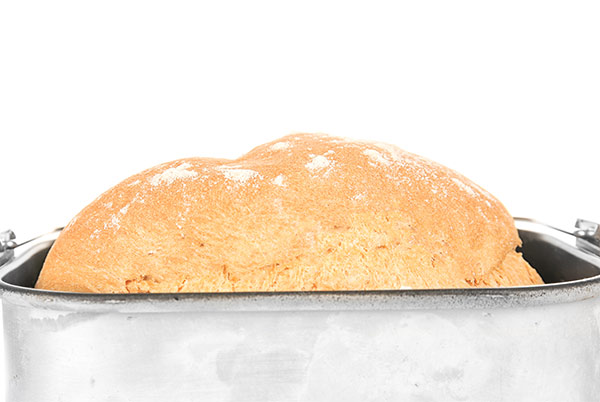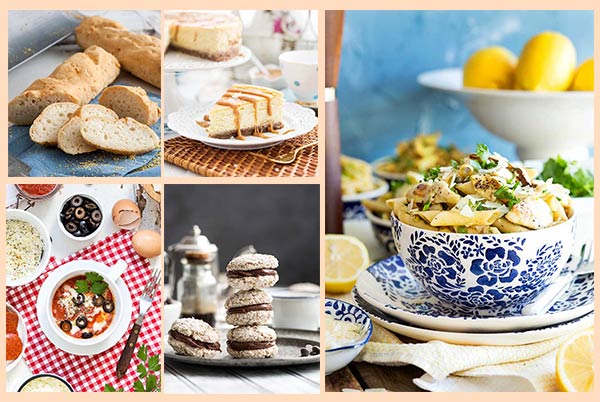Why Does My GF Cake Keep Sinking in the Middle?
Updated Apr 18, 2019, Published Apr 22, 2015
This post contains affiliate links. Please see our disclosure policy.
Q: What keeps causing my cake to sink? It always collapses in the middle as it cools.
Beth Hillson: We get this question all the time. Sinking cakes are a common complaint of gluten-free bakers but rest assured, it can happen to those who use wheat flour, too. A cake that puffs up as it bakes and deflates as it cools usually has had air beaten into the batter too quickly or vigorously. Because our gluten-free flours are heavier than regular gluten-filled flour, we’re tempted to keep beating in the dry ingredients to make sure they’re blended. Resist that temptation. Work the air in when creaming the butter, sugar and eggs, but use a lighter hand as you add the flour mixture. Fold the dry ingredients through the wet only until they’re just combined. Then gently divide the batter and pour it into your cake pans. If you add anything to the batter at the end (chocolate chips, raisins, etc.), fold them into the batter as gently as possible using a flowing motion.
Here are a few more tips to prevent sinking cakes:
- Beat the eggs and butter together at a moderate speed, not high. The air bubbles will be more stable.
- Add the eggs one at a time, beating briefly between additions.
- Don’t beat the mixture longer than the recipe instructs. Again, adding too much air before the cake bakes will lead to collapse as it cools.
- Unless a recipe specifically calls for it, don’t let the batter sit around for very long before baking. Sitting 20 to 25 minutes while the first batch bakes is fine; a few hours is not.
- Put your cake in the oven and let it bake undisturbed. Don’t open the oven door during the first 80 percent of baking time.
Q: Is there a difference between baking in glass or metal pans? Which is best for gluten-free baking?
Hillson: This question comes up frequently. Before I answer, don’t run out and replace your pans. Just understand the limitations of each type of material and accommodate them when you are baking. If your recipe isn’t behaving, it might be your bakeware, not the recipe.
Glass is an insulator. It takes longer to heat up than metal but once it does, it’s more likely to remain at a stable temperature and the heat distribution will be uniform. To compensate, you might have to extend baking time by 5 to 10 minutes. A glass pan is good for cakes and pies, which bake for a relatively long time at lower temperatures, but it’s not great for cookies, which bake for a short time. Glass bakeware isn’t made in large sizes. It’s more expensive and heavier than metal and it can shatter if its temperature changes too quickly.
Metal conducts heat better but often gets hot spots. To avoid this, you may need to rotate your pan midway through baking. Metal pans heat up and cool down quickly, which means they are good for items baked at high temperatures for short times, like biscuits. Metal with a dull finish absorbs heat faster than shiny metal, so cookies baked on a dull cookie sheet might get too dark on the bottom before they’re cooked on top.
My personal preference is heavy-duty Calphalon bakeware. These metal pans have a nonstick coating that’s bonded to the pan and won’t scratch or scrape off. Even so, I usually lightly grease the pan to prevent any possibility of my baked goods sticking to the surface.
Q: I want to double recipes of my favorite cakes, cupcakes and muffins. Do I need to make any special adjustments besides doubling all the ingredients?
Hillson: We all have favorite recipes that are a hit with everyone who eats them. It’s important they continue to please when they’re doubled. (Our reputations as gluten-free bakers are at stake!) So here’s the good news. It’s fine to double most recipes as long as you double all the ingredients and double the number of pans, cupcake holders or muffin tins you use. Don’t overload the pan and then double the baking time, thinking you’ll get bigger muffins or a larger loaf. You won’t like the results.
Q: Can I turn a layer cake into a sheet cake and into cupcakes?
Hillson: It’s easy to convert most cake recipes. A 9×13-inch baking pan equals just about two 9-inch round cake pans in volume. If you double the recipe, you’ll have enough batter for two 9×13-inch pans or half of a standard sheet cake (13×18 inches).
A cake recipe for a single 8- or 9-inch layer cake makes enough batter for 12 cupcakes. The baking time will be a bit less, about 18 minutes total.
For all these variations, be sure to test the cake for doneness with a wooden toothpick or cake tester. Begin testing a couple of minutes before you expect the cake or cupcakes to be done, as baking times will vary based on your oven temperature, your recipe and your pans.
Q: What’s the difference between baking powder and baking soda?
Hillson: Baking powder and baking soda are both leavening agents that help baked goods rise. Baking soda (bicarbonate of soda) is actually an ingredient in the more mild-mannered baking powder. A recipe will usually call for ¼ teaspoon of baking soda for every 1 cup or so of flour. Baking soda is usually a better choice than baking powder when the recipe includes acidic ingredients like buttermilk, yogurt, sour cream, citrus juice, molasses or brown sugar. Always mix baking soda with your dry ingredients first; it reacts when it hits moisture. Don’t let a batter made with baking soda stand around. For best results, get it in the oven right away.
Baking powder is made with a combination of baking soda, an acid (cream of tartar) and cornstarch (to absorb moisture). A recipe will usually call for 1 teaspoon of baking powder for every 1 cup or so of flour. Baking powder is perishable and should be stored in a cool, dry place. (Check the expiration date on the can). To test if it’s still good, add 1 teaspoon to 1/3 cup of hot water. If it doesn’t bubble up like it’s at a party, toss it and buy a fresh supply.
Written by Beth Hillson, originally published in Gluten Free & More.













